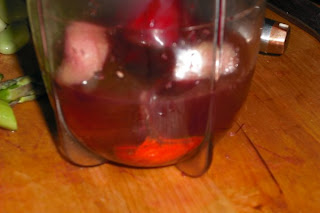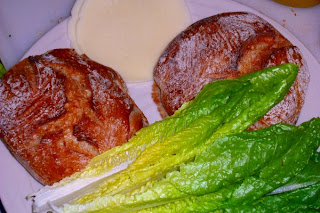One of the key ingredients in almost all baked goods, whether being used for browning purposes, crispness, or it's basic sweet quality, sugar is mysterious ingredient. Derived from multiple sources, Sucrose (
what we know as White Sugar) comes in MANY forms, some more refined than others.
Sucrose it primarily derived from Sugar Cane, however, Sugar Beets also provide a fairly high yield of the coveted crystal. Sago and Coconut palms, as well as the "Sugar" Maple and some species of Birch and Pine, can provide sucrose as well. Even honey contains some Sucrose, although it is mostly fructose, making it twice as sweet as table sugar, which is why most recipes call for 1/2 the amount of honey, as they would White Sugar.
I could actually sit here and type all night about the strange properties of sugar, like the fact that it is considered a wet ingredient when baking, due to it's affinity for water and its' humectant properties. (
Pulling moisture directly from the air, which is why it clumps if not properly sealed) But I am going to try to get to the main purpose of this post.
Understanding all the different types of Sugar and Sweeteners. This is how I understand the differences, the information presented here is only the basics, and just the tip of the iceberg, as it were. So if you feel the need to add information, please feel free to leave comments and expand upon this information. Thank you.. :)
Powdered/Confectioners' sugar - Smallest grain usually mixed with cornstarch up to 3% but not lower than 1.5% to keep it from caking. Application: Frostings, Fillings, Glazes, Icings, Mousses.
 Super Fine (
Super Fine (USA
) - Personally, I have only seen the C & H brand in the US. Tiny crystalled sugar, quick dissolving, measures differently than regular granulated sugar (
Castor Sugar in Europe; Berry Sugar in Canada) Applications: Meringues, Custards, ButterCreme,
 Castor Sugar
Castor Sugar (EU) - See Superfine; Called caster sugar because the crystals are small enough to fit through the mesh of a "sugar caster"
Berry Sugar (CAN)- See Superfine
Bakers Sugar - Slightly smaller crystal than regular Granulated but measures the same - Dissolves quicker in cold liquids; Easier to use than Super fine because measurements need not be modified; Applications: Meringues, Custards anything where quick dissolving is required.
Granulated Sugar - Regular White Table sugar
Light Brown - Same crystal size as granulated, because is is granulated sugar, but with 3% molasses added back in. Because of extra moisture, it must be packed down when measuring.
Dark Brown - Same crystal size as granulated, because is is granulated sugar, with 6% molasses added back in. Like light brown, dark brown contains extra moisture and must be packed down when measuring.
Muscovado sugar - A type of unrefined brown sugar that is dark and sticky due to it's high moisture content. Unlike most "Brown" sugar, which is originally granulated sugar with molasses added back into it, Muscovado retains it's original molasses content through the minimal processing. One of the "Designer Sugars", comes in light and dark varieties.
Turbinado Sugar - "Designer sugar" - is raw sugar that has been steam cleaned to remove contaminates... Holds more moisture than Granulated sugar, thus has fewer calories... 5 calories less per tsp to be exact, because of the water... Not all Turbinado sugar is created equal.
Barbados Sugar - "Designer Sugar" - Pseudonym for Muscovado, though may be finer grained. A very moist sugar that has been minimally processed retaining it's natural molasses. If using, recipes need to have the moisture content altered slightly to account for the extra moisture in the sugar.
Demerara sugar another "Designer Sugar" from Guyana is a type of raw sugar - is slightly larger crystal size containing its natural molasses. Applications; Great for crusting desserts such as creme brulee or
bread puddings.
 "Raw"/"Washed"/Sanding sugars
"Raw"/"Washed"/Sanding sugars are about the same crystal size - Sanding sugar is usually colored or CAN be colored.
Pearl/Nib sugar - Like small uniform version of lump sugar. About the size of a Cardamom seed. Applications; Folded into
Liege Waffle batters and sprinkled on various Scandinavian, Belgian, Dutch and German desserts
 Lump sugar
Lump sugar - Actual irregular compressed lumps of sucrose sugar, can be white refined, or contain molasses; sometimes known as "Coffee Sugar". Dates back long before modern "cube" sugar, thus the question... "One lump, or two?"
Cube Sugar - Uniformly cubic lumps of White granulated sucrose sugar
 Cone sugar
Cone sugar (Panocha or Panela) - an actual cone of "Brown" sugar that has been compressed (You can still fine the mold in antique stores) usually has to be scraped.
As a side note regarding Raw Sugars ----- the Brand "Sugar in the Raw" is not really a raw sugar... It's a name brand of sanding sugar with molasses sprayed on it... The molasses is only on the outside of the crystals. It is created by boiling down, not steamed. I think that C & H "Washed" sugar is the same thing, but I am not sure. I will have to do more research...
The closest to actual RAW sugar, since even those that can technically claim to be raw, are still technically processed in some way shape or form, are products like Sucanat that are evaporated cane juice, leaving all the molasses and trace minerals behind, although even these methods can be suspect as to whether the product is actually RAW or not. These "evaporated" sugars don't really form a cohesive crystal structure and are slightly powdery when crushed, like maple sugar.
 Sweetening sources besides Sugar Cane and Sugar Beets:
Date Sugar
Sweetening sources besides Sugar Cane and Sugar Beets:
Date Sugar - is not really sugar as we now it for baking... it is finely ground dried dates and does not dissolve.
Maple Sugar - Sugar from boiling the sap of the sugar maple tree - it's about 90% Sucrose mixed with glucose & fructose... Slightly sweeter than Cane or Beet sugar due to the Fructose content.
 Birch Syrup/Pine Syrup
Birch Syrup/Pine Syrup - More rare as the yield is much lower than the sugar maple, the Sucrose/Glucose/Fructose mixture is similar to that of Maple syrup.
Corn Syrup - Derived from Corn, primarily glucose with a few other sugars.
Applications; Candy making as it helps control the crystallization of Sucrose. Available in Dark and Light as well as the newer "brown Sugar" flavor.
This is unnaturally modified in a dual GMO enzyme process to create ....
High Fructose Corn Syrup - The Bane of the American People as it is hidden in just about every item of processed food; contains more calories than Cane Sugar.
OK, I am about to get a little opinionated.... Just a warning... HFCS is used in processed foods because it is a cheap sweetener, the reason it is "cheap" is that Cane sugar is expensive by comparison, the reason Cane sugar is expensive is because of Corn Lobbyist have succeeded in preventing the Import Tariffs on Foreign Cane Sugar from being lifted and that artificially inflates the cost. Thus the US's Cane sugar comes ONLY from Hawaii. Sugar Beets, however are grown in other states.
OK, I am done ranting now.... ;) Moving on ...
Palm Sugar - Similar to maple Sugar in process, it is produced from both Sago and Coconut palms; Jaggery is a type of Palm sugar from India as is Java Sugar (also in cake form)
Baker's Malt - 1/3rd the sweetness of granulated cane sugar. Produced from the "Malting" or sprouting and then kiln heating of barley (Just like beer, whiskey and malt vinegar) ... most people are familiar with "Malted Milk" which is a combination of Malt, wheat and milk powder, see also Ovaltine and Horlicks
Crystalline Fructose Sugar - A Simple Sugar usually available in health food stores and natural markets. Although there is now debate on whether consumption of this type of sugar is really healthy. Unlike Sucrose sugar which is a disaccharide (
2 simple sugars stuck together, one being fructose the other is Glucose), fructose being a simple sugar, thus it does not need to be broken down, and is processed by the liver. When used in baking, substitute half the amount as you would granulated since it is twice as sweet as Cane sugar.
Honey is high in fructose, this is why most honey recipes use half the amount that you would if using granulated sugar.
Updated - 07/12/10 - I left a couple of sweeteners out......
Agave Nectar - This has become extremely popular as it has a low glycemic index, thus can be consumed by diabetics without fear of blood sugar spikes. It has also become favored by Vegans as it is produced without bone char as is most white sugars (yes, they use bone char in both beet and cane sugar processing - Unless it's evaporated cane juice) Agave nectar is produced by boiling down the sap of the Agave plant. Don't worry, it's a different species of Agave, there will still be plenty of Blue Agave for making tequila. :)
Golden Syrup - Lyle's is the only brand I have ever seen in the U.S. as this is primarily a British product. Golden syrup is a pale version of Treacle. This is a form of inverted sugar. Inverted sugar is created by adding an enzyme (
invertase) to a cane sugar/water solution in the presence of an acid... say lemon juice. The enzyme breaks the Glucose-Fructose bond, so you end up with a syrup that has free glucose and free fructose. Golden syrup differs from High-Fructose corn syrup in that the process ends with the breaking of the glucose/fructose bond. HFCS undergoes and extra enzymatic step that actually changes some of the glucose into fructose using Xylose Isomerase.
Golden syrup IS sweeter than regular granulated sugar even though it's made from cane juice.... this is due to the free fructose, making it similar to honey both in texture and sweetening power. It is often used as a substitute by persons who abstain from honey.
I hope that sheds a little light on the scintillating world of sweeteners.
I think I need to go brush my teeth now....
~~



 Prepare the Favas, Leeks and Asparagus by blanching in salted boiling water for 2 minutes.
Prepare the Favas, Leeks and Asparagus by blanching in salted boiling water for 2 minutes. Remove from water with a skimmer and plunge into ice water to stop cooking.
Remove from water with a skimmer and plunge into ice water to stop cooking. Whisk while drizzling in the olive oil, until the mixture becomes slightly thickened.
Whisk while drizzling in the olive oil, until the mixture becomes slightly thickened. Pour about 1/2 of the dressing over the vegetables and toss.
Pour about 1/2 of the dressing over the vegetables and toss. Serve with Crusty Bread.
Serve with Crusty Bread.










































